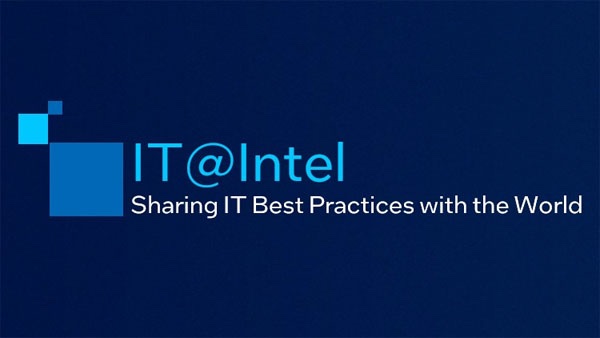IT Best Practices tagged posts:
 |
Intel IT operates 50+ data center modules across 15 sites, which house over 464,000 servers. To support Intel’s critical business functions, while operating our data centers as efficiently as possible, we constantly evolve our data center strategy. We run Intel [See the full post…]
|
 Read/Download PDF Read/Download PDF
|
|
 |
Intel IT is leading efforts to enhance outsourced semiconductor assembly and test (OSAT) operations. We have developed a confidential manufacturing infrastructure solution that protects sensitive data and intellectual property (IP) and is scalable to adapt to evolving demands and growth. [See the full post…]
|
 Read/Download PDF Read/Download PDF
|
|
 |
Managing Intel’s thousands of applications and millions of IT resources (such as identities, Domain Name System (DNS) records, accounts, certificates, VMs, databases, and more) requires capabilities beyond those found in commercially available application portfolio management (APM) solutions. We have developed [See the full post…]
|
 Read/Download PDF Read/Download PDF
|
|
 |
Intel IT’s agentic GenAI platform called One AI uses open-source tools to consolidate siloed chatbots into a single, unified agentic AI platform. Although it has a single user interface, each specialized agent addresses a unique business use case and chooses [See the full post…]
|
 Read/Download PDF Read/Download PDF
|
|
 |
As part of our regular PC refresh cycle, we are deploying AI PCs, which are powered by an eXtensible processing unit (XPU) architecture that integrates multiple types of processing units (such as CPUs, GPUs, and NPUs). We chose to begin [See the full post…]
|
 Read/Download PDF Read/Download PDF
|
|
 |
Intel IT is modernizing our enterprise architecture (EA) to accelerate Intel’s business transformation. Our goal is to simplify processes, more tightly manage IT assets, and drive EA innovation through AI. Initiatives include establishing federated governance, formalizing evaluation of emerging technologies, [See the full post…]
|
 Read/Download PDF Read/Download PDF
|
|
 |
Intel is entering a new era, with Intel Product and Intel Foundry as separate business entities. Through activities such as accelerated adoption of AI capabilities, data transformation, and ongoing modernization of factory and data center alike, Intel IT plays a [See the full post…]
|
 Read/Download PDF Read/Download PDF
|
|
 |
Modern electrical grids incorporate redundancy and automated rerouting to maintain a reliable electrical supply during equipment failures or natural disasters. Plants have coping mechanisms to deal with adverse conditions like drought. Similarly, it is important that IT systems, including applications, [See the full post…]
|
 Read/Download PDF Read/Download PDF
|
|
 |
Intel’s manufacturing landscape is evolving rapidly, driven by digital transformation and automation. Intel’s manufacturing facilities generate vast amounts of data that must be efficiently processed, analyzed, and secured to optimize operations and maintain competitiveness. In 2013, we deployed an “ultra” [See the full post…]
|
 Read/Download PDF Read/Download PDF
|
|
 |
Training models on Intel Gaudi accelerators is helping improve efficiency in Intel’s factories. Intel’s smart manufacturing environment relies on AI to improve yield, perform root-cause analysis, and accelerate anomaly detection. As Intel transforms to an internal foundry model, it is [See the full post…]
|
 Read/Download PDF Read/Download PDF
|
|
 |
Software-defined networking (SDN) is helping Intel IT keep up with Intel’s business expansion. We regularly experience an annual 25% increase in demand for data center network capacity. Furthermore, business pressures necessitate that new capacity be operational within 24 hours. As [See the full post…]
|
 Read/Download PDF Read/Download PDF
|
|
 |
Intel IT adopted a “right workload, right place” multicloud strategy nearly 10 years ago. This strategy has accelerated application development and deployment agility, achieved cost-responsible scalability, and enabled our business partners across Intel to achieve their business goals. A decade [See the full post…]
|
 Read/Download PDF Read/Download PDF
|
|
 |
To benchmark the end-user PC experience, Intel IT uses tools that clarify PC power consumption and applications’ effect on battery life. This helps us optimize the IT build and answer one of the most common questions we receive from users: [See the full post…]
|
 Read/Download PDF Read/Download PDF
|
|
 |
Intel IT’s Information Security (InfoSec) group has adopted capability-based planning (CBP) because it provides a framework for aligning our group’s strategies with Intel’s overall business strategy. CBP helps us prioritize projects and resources, communicate more effectively with business stakeholders, reduce [See the full post…]
|
 Read/Download PDF Read/Download PDF
|
|
 |
“Learn how Intel IT is gaining operational efficiencies resulting from a 5G private network in Intel’s manufacturing environment. Minimizing factory downtime and improving operational efficiency have always been the driving forces behind Intel IT’s push to digitize equipment in both [See the full post…]
|
 Read/Download PDF Read/Download PDF
|
|
 |
Thousands of Intel’s employees connect to the corporate Wi-Fi network every day. When connectivity issues occur, both productivity and user experience (UX) suffer. Intel IT makes every effort to optimize the network’s performance. Still, until recently, we had little visibility [See the full post…]
|
 Read/Download PDF Read/Download PDF
|
|
 |
Increasing Electronic Design Automation (EDA) performance and throughput is critical to Intel’s silicon Design engineers. Silicon chip Design engineers at Intel face ongoing challenges: integrating more features into ever-shrinking silicon chips, bringing products to market faster, and keeping Design engineering [See the full post…]
|
 Read/Download PDF Read/Download PDF
|
|
 |
Learn how Intel’s manufacturing engineers are using natural language processing (NLP) to streamline failure mode and effects analysis (FMEA). Intel Manufacturing Automation has developed an innovative methodology for performing FMEA in manufacturing by using artificial intelligence (AI) techniques to analyze [See the full post…]
|
 Read/Download PDF Read/Download PDF
|
|
 |
“Why is Intel IT modernizing Windows client management? Because a large part of Intel IT’s job is managing client devices—175,000 end-user and shared PCs for 124,000 employees. We need to consider many factors. Does a PC have the right drivers [See the full post…]
|
 Read/Download PDF Read/Download PDF
|
|
 |
Intel IT’s data center strategy is to apply breakthrough technologies, solutions, and processes to accelerate Intel’s business. We also run Intel data center services like a factory, e?ecting change in a disciplined manner. Our approach enables us to optimally meet [See the full post…]
|
 Read/Download PDF Read/Download PDF
|
|
 |
With the surge in the growth and adoption of Generative AI (GenAI) tools, Intel has seen hundreds of employees and teams begin using and developing tools based on commercial large language models (LLMs). Recognizing the immense potential of these tools [See the full post…]
|
 Read/Download PDF Read/Download PDF
|
|
 |
Intel is evolving quickly, and Intel IT is a key driver in that evolution. As the architects of Intel’s IT landscape, we are the strategic, trusted technology partner for Intel’s business. Our focus is on innovation, AI, and optimization as [See the full post…]
|
 Read/Download PDF Read/Download PDF
|
|
 |
Intel IT migrated enterprise data analytics to the cloud, enabling faster turnaround of business requests and increased operational efficiency.
|
 Read/Download PDF Read/Download PDF
|
|
 |
Intel IT is using computer vision and AI for inline inspection in Intel’s assembly and test factories. Keeping Intel’s global network of factories running at top efficiency is one of Intel IT’s primary roles. Over the last decade, we have [See the full post…]
|
 Read/Download PDF Read/Download PDF
|
|
 |
Learn the latest in Intel IT’s approach to fault detection for factory equipment. For many years, Intel IT has utilized a standard infrastructure with Industrial Internet of Things (IIoT) sensors and Intel IoT Gateways for various applications on the factory [See the full post…]
|
 Read/Download PDF Read/Download PDF
|
|
For more information on Intel IT best practices, please visit www.intel.com/IT



































